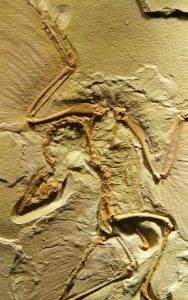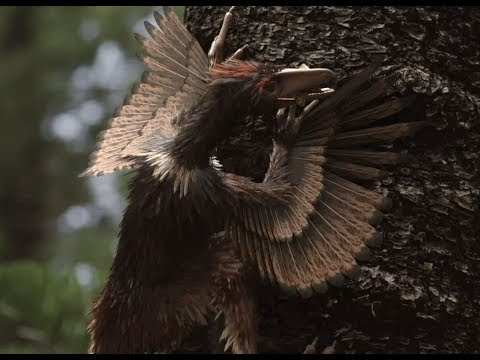Archaeopteryx, Was It a Bird or Dinosaur?
Table of Contents
Archaeopterx was a primitive bird that lived in what is modern-day Germany during the late Jurassic period. Its name means “ancient wing,” and the first complete fossil was found in 1861. The discovery of Archaeopteryx created a debate about evolution and what is known today as transitional fossils.

A total of ten fossils have been found since 1861, and this species is well documented. All of the fossils were found in Germany embedded in limestone, which preserved them quite well. The discovery of the Archaeopteryx, along with similar species found in China during the 1990s has greatly added strength to the idea that birds are linked to dinosaurs.
The Archaeopteryx was similar in size to the modern Magpie bird. It had short wings that were broad, and it had a long tail. The feathers were much like modern birds, but there were also some notable differences between Archaeopteryx and modern birds. It had jaws that were filled with sharp teeth, and three of its fingers were tipped with claws, and it also had a bony tail.
The discovery of Archaeopteryx gave powerful evidence that modern birds evolved from dinosaurs. While it is probably related to modern birds, Archaeopteryx is not believed by paleontologists to be the direct descendant of birds which live today. The biggest debate among paleontologists is whether the animal hopped or could actually fly.

While some believe that Archaeopteryx could fly, others believe it was only capable of hopping or gliding from trees. Because it doesn’t have a strong breastbone, this is evidence that it wasn’t good a flying. Strong flight muscles connected to its wishbone, and this is a feature that many birds have. Because it had large wings and a tail, this was evidence that it could fly and maneuver in the air. Its wings were also shaped like many modern birds.
In 2004 a CT scan was done which analyzed the braincase of Archaeopteryx, and based on the results it appears it had a brain large enough to allow it to fly. The brain of the animal was constructed using the computer, and the areas which handle vision take up a large part of its brain. The brain was also developed for hearing. The structure of the brain is more like a modern bird than a reptile.
At the same time, other scientists believe the Archaeopteryx climbed trees and could glide like some modern-day squirrels. However, only time will tell which theories turn out to be accurate.
There has long been a debate over the evolution of birds, though when faced with the histology of the Archaeopteryx, dinosaurs are birds’ most likely ancestors.
Birds, when examined with an objective eye, are very strange-looking compared to the many other types of living animals. They characteristically have beaks (features which only really appear elsewhere with anapsids and squid), feathered bodies, and scaly, reptilian feet.
It has long been popularly believed that birds are the result of one evolutionary thread of dinosaurs. This was postulated to the masses, partly in thanks to paleontology consultant James Horner, in Jurassic Park, as Dr. Grant explains to a young boy how a velociraptor was similar to a large turkey. Hyperbole, perhaps, but recent research only supports the ideas behind this statement.
Archaeopteryx and the Evolution of Avian-Like Creatures
Recently in a paper published in the journal PLoS ONE (“Was Dinosaurian Physiology Inherited by Birds? Reconciling Slow Growth in Archaeopteryx“) , a group of paleontologists, led by Gregory M. Erickson of Florida State University, explain some remarkable findings that emerged from intensive histological scrutiny of several skeletons of Archaeopteryx, whose name translates to “old bird.” Archaeopteryx is the oldest specimen of a bird-like creature that has been discovered (belonging to a group called Avialae), which makes it a great starting point for determining where modern birds may have come from.
Erickson and his associates describe the bone structures of Archaeopteryx by highlighting the similarities that exist between their long, parallel-fibered bones and the similar bones of non-avialan (not bird-like) dinosaurs. Based on this histological discovery, the bones of the Archaeopteryx were slow-growing, unlike modern birds, and more along the lines of the growth rates of non-avialan dinosaurs.
Archaeopteryx has often been coined, due in part to its name, as the oldest known bird. Even with its long, bony tail, and its mouth full of teeth, it is still often considered a prehistoric version of living avian creatures. However, it seems based on this research, that this creature wasn’t really a bird at all, rather just a dinosaur that flew and had bird-like characteristics, placing it into that Avialae group previously mentioned.
Archaeopteryx: Bird or Dinosaur?
Erickson and the other researchers conclude, based on the histological and anatomical breakdown of Archaeopteryx‘s skeletal remains, that the “oldest bird” was a primitive precursor to birds, but cannot correctly be considered a bird in the modern sense.
Flighted, avialae dinosaurs may have been the precursors to modern birds, but they must be considered only that: precursors. To refer to the Archaeopteryx and other avialae dinosaurs as “birds” would be erroneous and misleading.
While their study with Archaeopteryx does not lend too much to the wide-scale debate on the origins and evolution of birds, it seems the Archaeopteryx can, with conviction, be removed from the equation.
Resources:
- Erickson GM, Rauhut OWM, Zhou Z, Turner AH, Inouye BD, et al., 2009.
- Was Dinosaurian Physiology Inherited by Birds?
- Reconciling Slow Growth in Archaeopteryx. PLoS ONE 4(10): e7390. doi:10.1371/journal.pone.0007390
